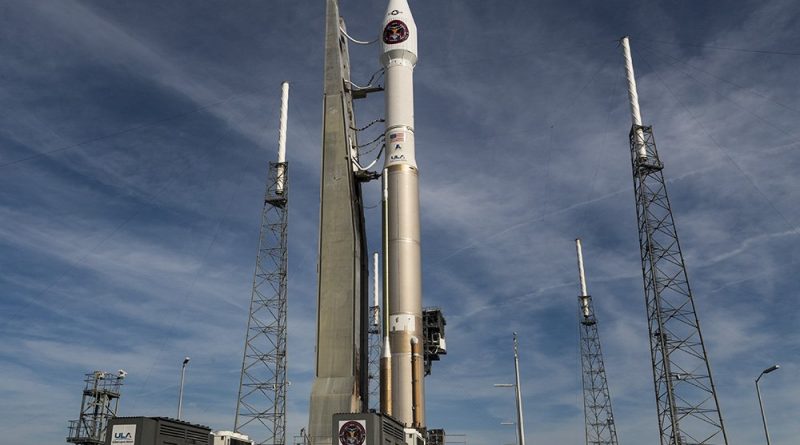Atlas V rolls out for Year-Opening Launch with critical U.S. Missile Warning Asset
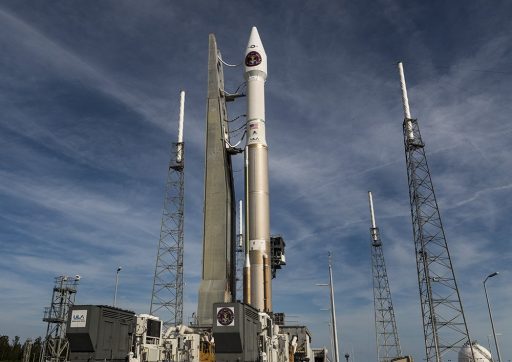
A United Launch Alliance Atlas V stands tall atop its Cape Canaveral launch pad as it awaits the rocket’s first mission of the year on Thursday, the delivery of a vital asset for U.S. Defense Forces.
Designed to detect and track enemy missiles, the SBIRS-GEO 3 satellite will join the Space-Based Infrared System that provides a crucial surveillance post high above the Earth, tracking all types of ballistic missiles all across the globe.
Atlas V is set for liftoff during a 40-minute launch window opening at 0:46 UTC on Friday, 7:46 p.m local time on Thursday, embarking on a mission of 44 minutes that aims to deliver the satellite to a standard Geostationary Transfer Orbit. Following liftoff, Atlas V will power uphill using its Russian-built RD-180 engine that will fire for the first four minutes of the flight before the Centaur upper stage takes over for a pair of firings of its RL-10C engine, first putting the stack into a Parking Orbit followed by a second boost to raise the orbit’s high point to nearly 36,000 Kilometers.
Thursday’s launch will open another busy year for United Launch Alliance, currently with at least 11 launches on the manifest for 2017 – most in support of national security.
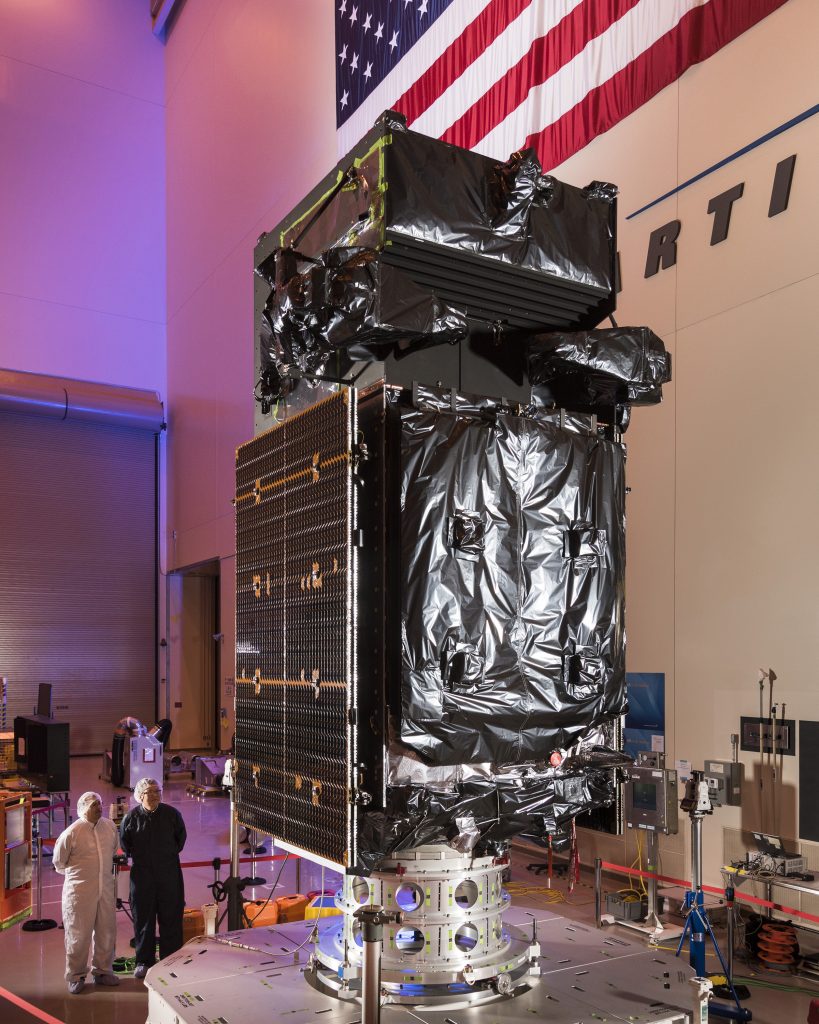
The Space Based Infrared System, SBIRS for short, is considered one of the Pentagon’s most critical missions, providing early warning of missile attacks anywhere in the world. The multi-billion Dollar program was formally initiated in 1996 to replace the Defense Support Program that provided missile warning capability since the early days of the Cold War and was being replaced after nearly four decades of operation.
While the detection of intercontinental ballistic missiles was a prime objective during the Cold War era, today’s system also has to be able to detect threats of short-range missiles by incorporating a highly flexible system capable of detecting faint signatures of short-range missiles while also watching over the entire globe to detect ICBMs.
SBIRS comprises dedicated satellites in Geostationary Orbit, hosted payloads operated from Highly Elliptical Orbits to provide coverage in the northern regions, and a completely new, integrated ground segment to distribute information faster than before. In the initial stages of the program, SBIRS satellites join their legacy Defense Support Program counterparts before SBIRS will fully take over once four GEO satellites are operational.
The first SBIRS-GEO satellite launched in May 2011 and was followed by SBIRS-GEO 2 in March 2013, both were lofted into orbit by the trusted Atlas rocket. They currently cover a large stretch of the globe including areas of interest such as the Middle East and the Korean Peninsula. SBIRS payloads in Highly Elliptical Orbits launched as hosted payloads on National Reconnaissance Office missions in 2006, 2008 and 2014.
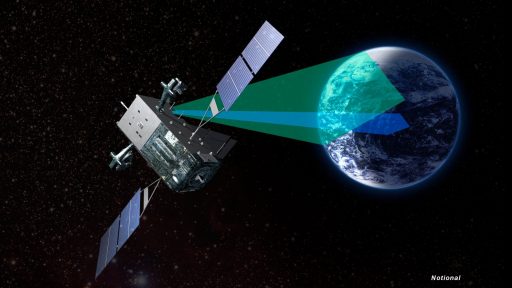
SBIRS-GEO 3 will further expand coverage of the SBIRS system, offering a much higher sensitivity and revisit rate than their aging predecessors which will remain active until SBIRS-GEO 4 – launching later this year – will be declared operational to allow SBIRS to cover the entire globe. The sensitivity of SBIRS is paramount when attempting to detect short-burning & short-range missiles that only appear as very brief & dim targets to a satellite in Geostationary Orbit.
SBIRS-GEO 3, coming with a price tag of around $1.2 billion, is functionally equivalent to the first two SBIRS satellites, built by Lockheed Martin on the popular A2100 satellite platform used in commercial and military communications satellites as well as specialized applications such as SBIRS and GPS. Built for a 12-year design life, the satellites host radiation-hardened RH-32 computers that can be reconfigured in flight and a pair of two-panel solar arrays generate around 3kW of power for the satellite’s various subsystems.
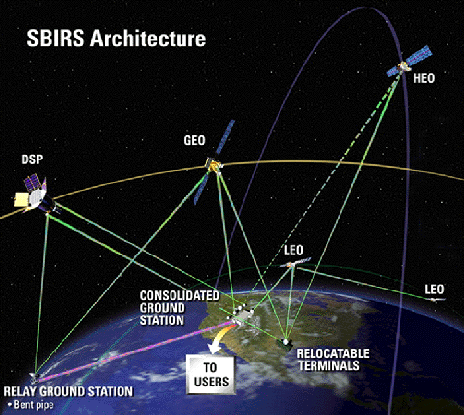
A large deployable sunshield will unfold to protect the satellite’s high-fidelity payload comprising a scanning and staring sensor, both sensitive in three infrared bands.
The scanning sensor is responsible for collecting global data at a high revisit rate to detect intercontinental ballistic missiles while the staring sensor either keeps focused on a single location of interest or steps between multiple areas to detect the low-signature of short-range missiles that could represent a danger to U.S. troops stationed abroad. The instruments cover short wave, mid wave and see-to-ground spectral bands and, in addition to missiles, can detect wildfires and volcanic eruptions as well as re-entering space debris.
With SBIRS, the time it takes to detect & track a missile launch is cut in half, feeding more timely information into the warning network to protect the U.S. homeland, military forces abroad and allied nations. Given the importance of space-based missile detection, two additional SBIRS satellites were ordered in 2014 to extend the operational life of the program through the end of the next decade.
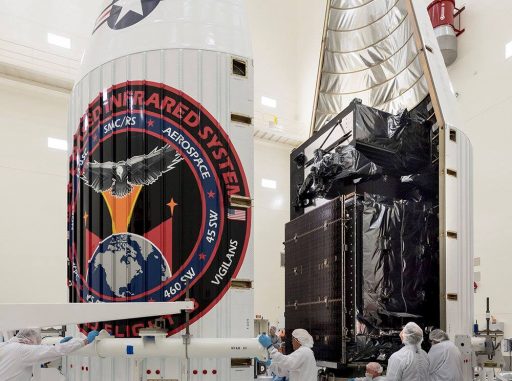
The Atlas V set to launch SBIRS-GEO 3 on Thursday started assembly back on January 5 in a bid to become the fastest on-pad campaign to date for the workhorse launcher as ULA continues to streamline the process of preparing Atlas V for launch. Over the past years, the Atlas V 401 processing time – measured from the arrival of the first stage at the launch complex to the rollout of the rocket – shrunk from around a month to just two and a half weeks. Wednesday’s rollout set the record at 13 days.
The maturing of the Atlas V launch system now allows for streamlined assembly and processing, eliminating time-consuming steps such as the Wet Dress Rehearsal which once was part of every launch campaign and now is only conducted for missions with constrained launch windows. Improvements have also been made in pre-flight testing to catch subsystem issues sooner in the processing flow, typically before the rocket arrives at the pad.
SBIRS-GEO 3 was delivered to Cape Canaveral back in August 2016 for an expected launch in October that needed to be pushed when two satellites equipped with the same main engine as SBIRS ran into problems during their orbit-raising campaigns. Exercising caution, the Air Force put processing of the satellite on hold while reviewing the issues encountered by the other missions, ultimately clearing GEO 3 to fly as is.
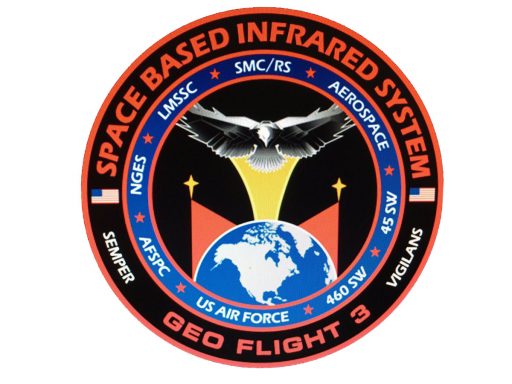
The satellite was encapsulated in the four-meter payload fairing of the Atlas V and took its spot atop the rocket last Thursday to mark the start of a final integrated testing campaign of the fully assembled vehicle. A clean Launch Readiness Review on Tuesday gave the green light for the launch and Atlas V completed its 45-minute trip to the launch pad at Space Launch Complex 41 Wednesday morning.
Weather forecasters have issued an 80% chance of cooperative weather during the mission’s window on Thursday to kick off a busy year for United Launch Alliance. Of the eleven missions currently on the manifest, eight will be carried out by the Atlas V, two will fly on the Delta IV and the second-to-last launch of the venerable Delta II is also planned.
ULA’s 2017 manifest has four missions booked by the National Reconnaissance Office, four satellite deliveries for the U.S. military, two missions for NASA and a single commercial contract with Orbital ATK for a cargo delivery to the International Space Station. Atlas V has more slots available that may be taken up by commercial customers through ULA’s RapidLaunch initiative that allows repeat customers to purchase missions at lead times as short as three months.
Countdown & Launch Sequence
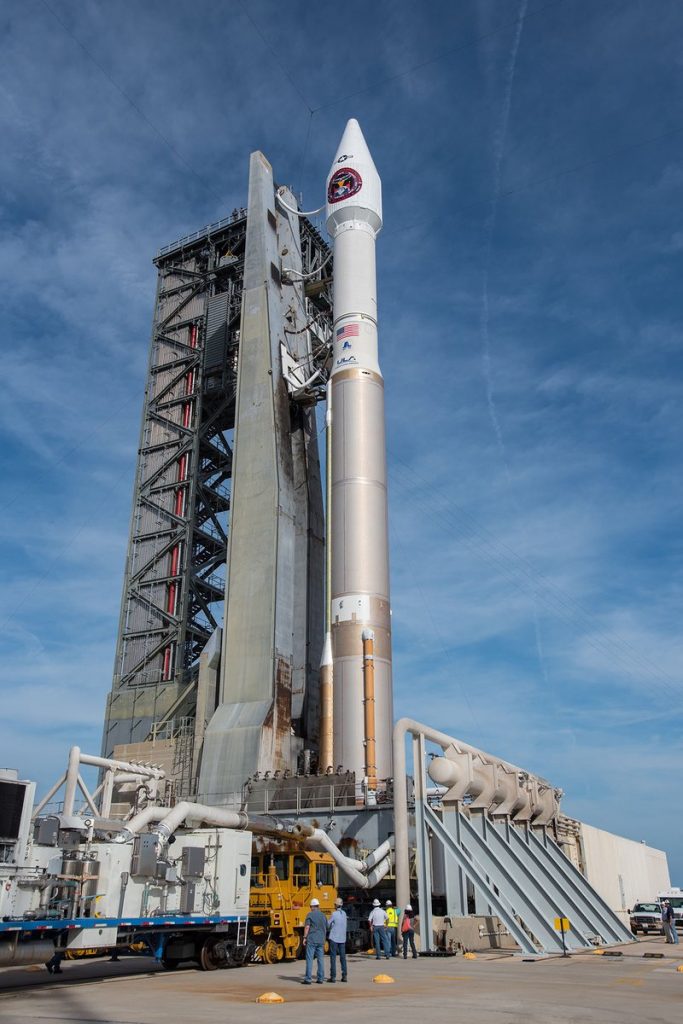
Atlas V enters its lengthy countdown operation seven hours prior to the day’s T-0 target with the activation of the two-stage rocket to then undergo a multi-hour checkout operation to ensure all subsystems are ready to support the mission. At the pad, the first hours of the countdown are dedicated to final physical reconfigurations to button up the launch vehicle and ground facility before engineers depart the complex to enable hazardous operations to commence.
Approaching L-4 hours, the Launch Team puts the Atlas V through a series of communication checks on its S- and C-Band Systems and also goes through Flight Termination System testing before applying the purge flow to the vehicle in advance of propellant loading.
At T-2 Hours, the countdown enters a built-in hold during which teams perform the fueling pre-task briefing and the GO/No GO Poll for propellant loading. As soon as the countdown resumes at T-2 Hours, propellant loading operations start. The complex procedure to load the two stages of the rocket with cryogenics begins with the chilldown of ground support equipment and transfer lines and tanks chilldown on the Liquid Oxygen side.
Liquid Oxygen starts flowing into the Centaur upper stage tanks shortly thereafter, starting a 40-minute sequence to load the tanks with around 15,700 liters of –183-degree Celsius oxidizer.
Once Centaur is into propellant loading, the large Liquid Oxygen tank of the Common Core Booster also starts fueling. LOX load on the CCB also moves through the three steps, slow-fill, fast-fill and topping. The Common Core Booster is loaded with Rocket Propellant 1 (refined Kerosene) ahead of the launch countdown.
The final tank to be loaded during the countdown is the Liquid Hydrogen Tank of the upper stage that also goes through the usual steps to be filled with 48,100 liters of -253-degree Celsius LH2 fuel. Centaur can look back at over 200 previous missions – most of which coupled with an Atlas – a duo that has been operating for several decades.
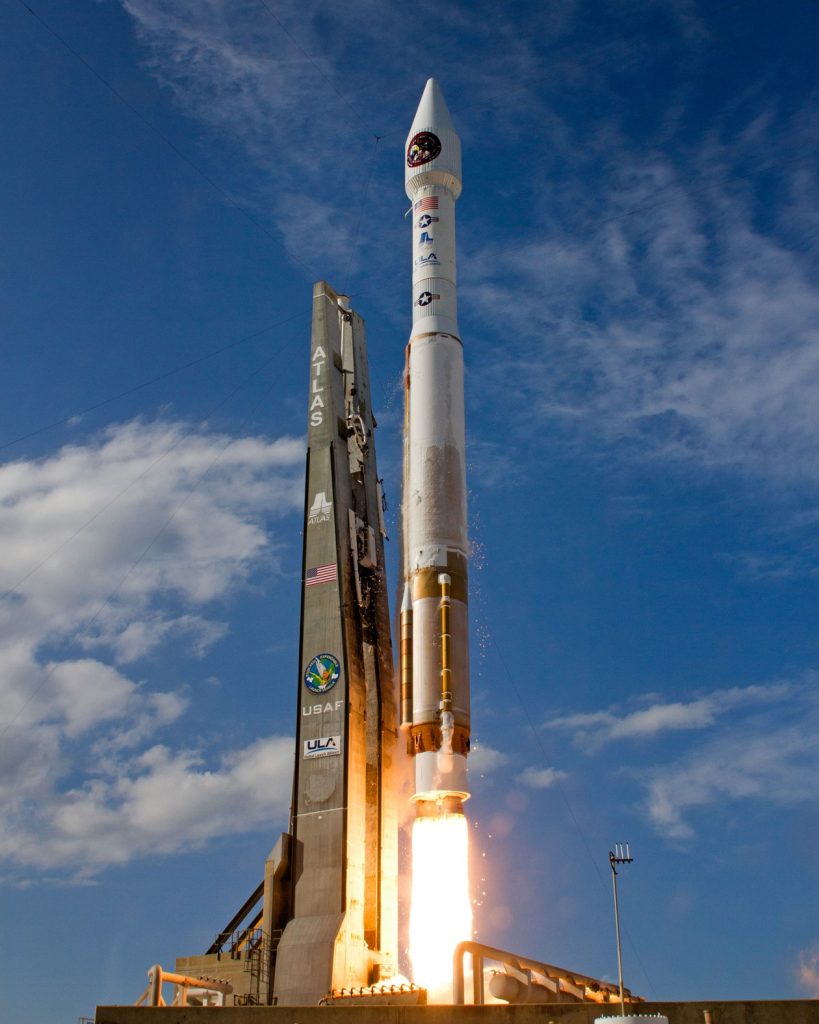
When clocks reach T-4 Minutes, the countdown enters its second built-in hold for final polling of the launch team prior to pressing into Terminal Count. This hold can be extended in case of technical issues or uncooperative weather.
As clocks start ticking down from T-4 Minutes, final vehicle configurations such as ordnance arming, flight termination system arming, propellant tank pressurization, transfer to internal power, and flight control system reconfigurations will be made as part of the Automated Sequence to place the vehicle in its launch configuration.
At T-2.7 seconds, the massive two-chamber RD-180 main engine of the Common Core Booster ignites and soars up to its full liftoff thrust of 390,250 Kilogram-force. Engine start-up is closely monitored by flight computers to make sure it reaches operational conditions before the launcher is committed to flight. As clocks hit zero, the hold-down system releases the launcher and Atlas V blasts off.
Without any Solid Rocket Boosters, the Atlas V 401 gracefully lifts off its launch pad with a Thrust to Weight Ratio of 1.16, making for a fairly slow climb-out.
After ascending vertically for 18 seconds, the Atlas V will begin its pitch and roll maneuver to align itself with its pre-determined flight path, departing Florida’s Space Coast to the east-south-east along a launch azimuth of 95.9 degrees – the standard route to Geostationary Transfer Orbit from Cape Canaveral.
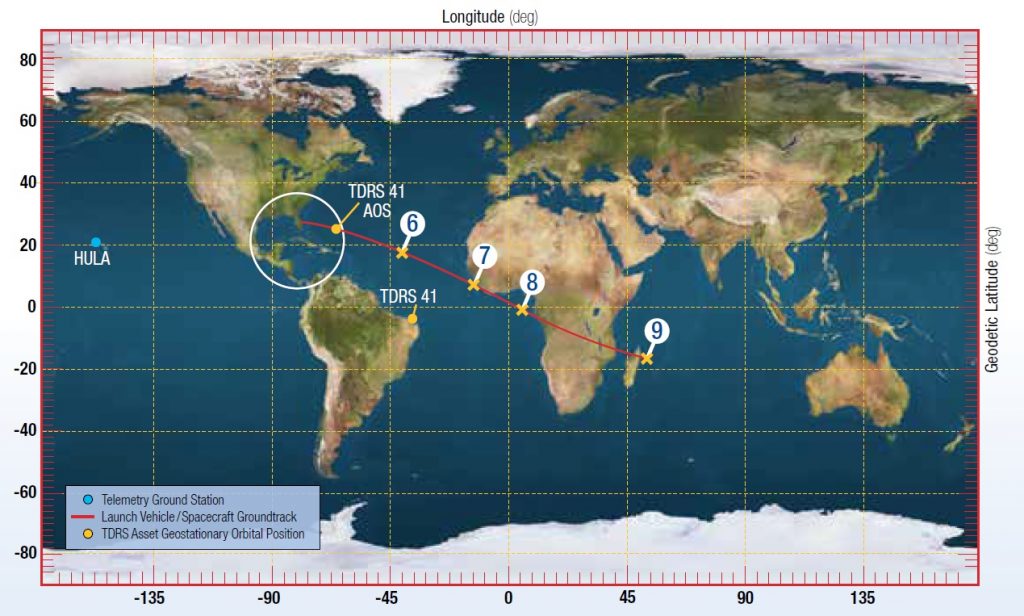
After 80 seconds, the rocket passes Mach 1 followed by Maximum Dynamic Pressure about ten seconds later. While the RD-180 continues full steam ahead at a vacuum thrust of 422 metric tons, the Centaur upper stage will prepare for its first ignition by chilling down its RL-10 engine and opening a pyrotechnic valve to initiate the pressurization of the Reaction Control System.
Approaching the four-minute mark, RD-180 will begin a gradual throttle back to limit acceleration at the end of the first stage burn.
Four minutes and three seconds into the flight, the first stage will shut down its RD-180 engine after burning 284 metric tons of Kerosene and Oxygen. Six seconds after BECO, pyrotechnics will be fired to separate the Common Core Booster that then uses eight small solid rocket motors to move away from the Centaur upper stage.
At T+4:19, the RL-10C engine of the Centaur Upper Stage will ignite on its first burn, a planned 11-minute and four-second firing to deliver the stack into a Low Earth Parking Orbit as part of a standard two-burn GTO mission profile. Ten seconds into the Centaur burn, Atlas V will split open its four-meter payload fairing and jettison the fairing halves to shed no-longer needed weight as aerodynamic forces can no longer harm the satellite once over 100 Kilometers in altitude.
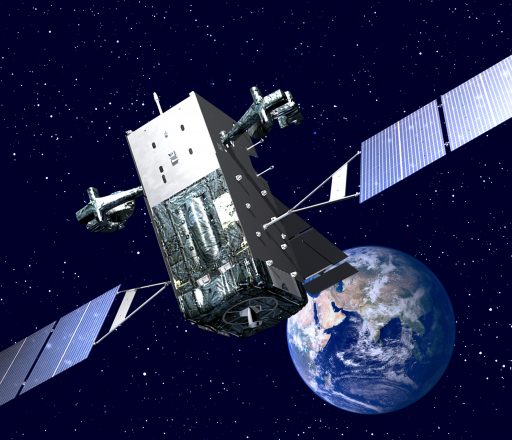
Following MECO, Centaur will enter a passive coast phase of ten minutes, required to set up the proper insertion parameters for the rocket’s second burn.
While coasting, Centaur maintains a stable orientation as it heads across the Atlantic Ocean to conduct its second burn around the equator to position the high point of the final injection orbit over the equator on the other side of the planet to ease the process of phasing the satellite into its operational Geostationary Orbit.
Re-start of the RL-10 engine is planned right at the T+25-minute mark and Centaur will fire for three minutes and 38 seconds to significantly raise the apogee of the orbit, aiming for injection into an orbit of 185 by 35,786 Kilometers, inclined 23.29 degrees.
Separation of the SBIRS-GEO 3 satellite is planned just shy of T+44 minutes, over the Indian Ocean, just east of the island of Madagascar. Following separation from its launch vehicle, SBIRS-GEO 3 will begin a nine-day sequence with six firings of its main engine to lift itself into Geostationary Orbit, nearly 36,000 Kilometers above the equator where the satellite’s speed matches the Earth’s rotation so that the spacecraft can remain locked over one location. The Air Force did not disclose from where the satellite will operate.

